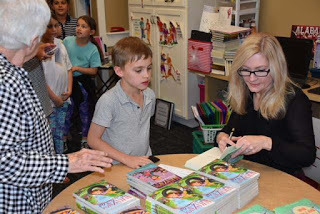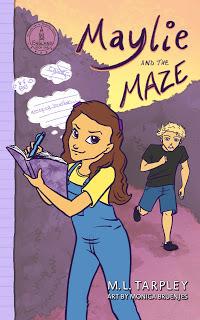Marcia Thornton Jones's Blog, page 76
November 11, 2020
Don't Make Me Choose!
Each morning I find myself contemplating an ever-changing list of things I'm grateful for. While it always starts with family and friends, it may include such wide-ranging thoughts as puffy clouds, warm chocolate chip cookies, comfortable shoes, fresh metaphors, a stranger's smile, or the fact that the song currently playing in my mind is actually one I like.
No problem with that, right? The problem only creeps up when we get to the most fun part of school visits: Q&A. It rarely fails. One kiddo or another will ask, "What/who is your favorite—" I want to stop them right there. Truth is, I don't have a single favorite anything. I love lots of things, and that list frequently changes.
When they ask about my favorite color, for example, I'll explain my affinity for combinations, like fire colors of red/orange/white, perfect-day colors of spring green/deep sky blue, the slightly offbeat yellow/purple combination; or even that I love the word cerulean, the way it bounces off the tongue. For food, I might mention (at least, today) pizza, watermelon, enchiladas, fried chicken, panang curry, mashed potatoes, chicken piccata, a good burger, the happiness that lives inside cookies, and and and...
However, when they ask about favorite books and authors -- especially, which ones inspire me -- I've actually come up with an answer. It takes the form of ever-changing, ever-growing slides. (Yay, PowerPoint!)
So, this month, surprise! I will not highlight an author or a book or even a genre that I'm grateful for. Instead, I'll share just two of my presentation slides with you. Each book here holds a certain magic for me. And sometimes, magic is better left unexplained.*
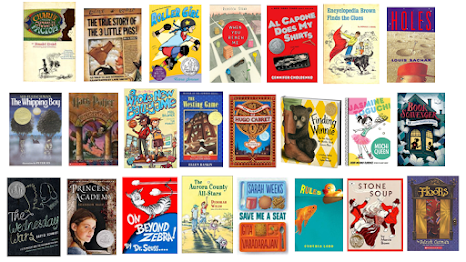

*If you'd really like to know the whys behind a title or two, though, happy to explain. Just ask.
November 8, 2020
GRATEFUL TO E. NESBIT -- by Jane Kelley
My mother always wanted me to read her favorite children's novel, The Bastable Children by E. Nesbit. But why would I want to look inside these covers?

Bastable? What kind of name is that? No picture? No promise of anything fun? No thanks.
So I didn't read it until decades later when I was writing kids novels myself. In my second book, The Girl Behind The Glass, I imagined a ghost who had a beloved book. Since that ghost was about my mother's age, I decided to use my mother's own favorite.
The very first page hooked me. "We are the Bastables. There are six of us besides father. Our mother is dead, and if you think we don't care because I don't tell you much about her, you only show that you do not understand people at all."
E. Nesbit does understand people. She wrote her books over a hundred years ago. The children who are the heroes of her stories wore different clothes and ate puddings.
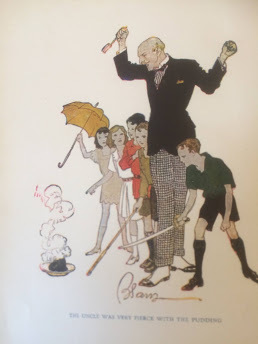 "The uncle was very fierce with the pudding."
"The uncle was very fierce with the pudding." And yet we know them. As E. Nesbit said, "When I was a little child I used to pray fervently, tearfully, that when I should be grown up I might never forget what I thought and felt and suffered then."
Her ability to depict the emotional reality of sibling squabbles is not why her books are so beloved. Yes, there is a pudding in that illustration, but there is also a sword. As the book's cheeky narrator said, "The best part of books is when things are happening. That is the best part of real things too."
Things happen. Do they ever! The kids encounter magic carpets, treasure hunting, time travels, and a very grumpy Psammead, which is a sand fairy. It reluctantly grants the children wishes that never quite turn out the way they're supposed to.
 The Psammead.
The Psammead.Nesbit paid attention to the reality. The magic in her books seems real because she included fascinating details. When the kids have a magic carpet, it's a carpet that has been repaired. The rewoven section isn't as powerful, and so whoever sits on that part doesn't travel with the rest. What a brilliant detail! Gore Vidal wrote in the NY Review of Books: "Though a child will gladly accept a fantastic premise, he will insist that the working out of it be entirely consistent with the premise."
Children still want magic. All readers do. Eleanor Fitzsimons wrote in the Irish Times: "Nesbit offered us the potential for magic at a time in our lives when the boundary between reality and imagination is at its most porous."
"The key to Nesbit's appeal is her ability to write just like one of us. The adventures she describes, though clearly impossible, feel utterly authentic. Surely they could happen to you or me if we were fortunate enough to dig up a grumpy Psammead or stumble upon a broken amulet in an old junk shop."
We want magic. We need magic. But in order for us readers to fully embrace that magic, it needs to be grounded in reality.
Like so many other authors who admire E. Nesbit -- from C. S. Lewis to J. K. Rowling -- I try to include magic in my books without sacrificing realism. Yes it's more challenging. But reality makes it more interesting. Just like that carpet that doesn't always take you where you expect to go.
November 2, 2020
Interview with New Smack Dab Blogger Deborah Kalb (Author of Thomas Jefferson and the Return of the Magic Hat) - Holly Schindler
Today, I'm delighted to introduce new Smack Dab blogger Deborah Kalb to our readers with an interview. Her latest book, Thomas Jefferson and the Return of the Magic Hat, just released from Schiffer Kids, and it seemed the perfect place to start:

HS: Please tell us about The President and Me—elevator pitch.
DK: A series of middle grade novels about fifth graders in present-day Bethesda, Maryland, who have amazing time travel adventures and meet the early presidents—while also dealing with modern-day concerns.
HS: Where did the idea for the time-traveling hat come from?
DK: I went to Mount Vernon, George Washington’s home, some years back, and noticed the tricornered hats that colonists used to wear. When it came time to create a magical being that would take my present-day characters back to the 18thcentury, a talking hat seemed perfect! The hat first appeared in book 1, George Washington and the Magic Hat.
When I considered what to do for book 2, which focuses on John and Abigail Adams, I fastened onto the John Adams bobblehead that my family got from the John Adams historical site in Quincy, Massachusetts. A crotchety, talking John Adams bobblehead! From that emerged John Adams and the Magic Bobblehead.
With this new book, I thought the hat might have more to say, so I brought it back in Thomas Jefferson and the Return of the Magic Hat, the new addition to the series.
HS: Tell us about your journalism background. How did it help with this project?
DK: I spent many years as a journalist covering politics and government. I also was a history major in college, and worked on reference books over the years about history and government. My journalism background is part of my ongoing interest in trying to understand how the government works, and how this country’s history affects what’s going on today.
In addition, as a journalist I was usually on very tight deadlines, which helps motivate me now when I’m researching and writing my books!
I’ll say more about journalism and a free press in response to one of your later questions…
HS: In this current political climate, I’ll admit that I was more than just a little intrigued about your choice to write about Thomas Jefferson. How long was this project in the works? Did you ever have any second-thoughts about the project? How did current events help shape the book? (For example, you do mention Charlottesville in the text.)
DK: That’s a great question. The quick answer is that I started working on this series about six years ago, and I’m writing about the presidents in order, so Thomas Jefferson came after George Washington and John Adams and it was his turn.
Of course there’s a lot more to it than that. I knew going into the project that slavery and Jefferson’s relationship with Sally Hemings--an enslaved woman at Jefferson’s plantation, Monticello--would play a big role in the story. In book 1, I also discuss slavery in relation to George Washington, and invite readers, along with my present-day characters, to contemplate how the country’s first president could have enslaved other people.
But in this new book, I decided that one of the main characters my present-day protagonist, Oliver, would meet back in time would be Madison Hemings, the son of Thomas Jefferson and Sally Hemings. Madison Hemings grew up as an enslaved person at Monticello. While his mother never gained her freedom, Madison Hemings and his siblings did become free as adults.
As an older adult, Madison Hemings wrote a short memoir describing his childhood at Monticello and his family history. I used that and other research on him to make his story an important part of the book.
I didn’t have second thoughts about the project because I wanted to write about this issue and describe Jefferson in all his facets. And let my characters contemplate that paradox: how the author of the Declaration of Independence could have held other people in slavery.
You’re right that I mentioned Charlottesville. I don’t want to tie my books to a specific year, given that it’s a series and the characters stay in fifth grade, so I try to avoid time-specific references, but I felt it was important to mention given that my characters were visiting Monticello and the University of Virginia, and that the book itself deals with issues that are very timely.
HS: You address Jefferson’s “conflicting beliefs”—and yet, as much as the young characters want definitive answers from Jefferson, about how he could, as you say, “write the Declaration of Independence and yet own other people, including people who were related to him,” they really don’t get any. I’m assuming this is because you can’t put words in Jefferson’s mouth, but it also seems to be to encourage further discussion and research. Can you address that?
DK: Yes, thank you for asking that. You assumed correctly. I try to stick to what Jefferson said rather than come up with ahistorical non-facts that I would make him say in the book. I did a great deal of research for each book, and I do my best to make the sections of the books set in the 18th and 19thcenturies be as accurate as possible. (If you take the time-travel element out!)
And of course, I would like to encourage discussion and research. Just as the fifth graders in my books wonder about these conflicting beliefs, I hope my readers think about that too, and try to find out more. It’s important to recognize all facets of historical figures, both the positive things they did and the horrendously negative.
HS: In an MG, it had to be somewhat tricky to navigate which details to include regarding slavery—especially the relationship between Jefferson and Hemings. How did you make that decision?
DK: I knew I needed to include their relationship in the book, as I’ve discussed above. But yes, it was tricky to decide how to approach the subject in a middle grade novel. I remember talking with my son’s wonderful former fifth grade teacher for some advice.
I came to the conclusion that the best way to approach it was through Madison Hemings, rather than Sally Hemings. Madison Hemings had written his memoir, so there was a historical record of his life, and I think it’s always good to include historical figures shown as kids. In book 2, John and Abigail Adams’ kids play a major role in the story, for example. It makes the history more relatable.
HS: This plays off an earlier question, but you also address issues of free press here. I especially appreciated the quote about preferring “newspapers without a government,” should a decision between the two have to be made. That quote seems especially pertinent today. Can you speak to that a bit?
DK: Yes, this is an important issue. As a former journalist myself, I really appreciated Jefferson’s willingness to praise newspapers—in contrast to what’s going on today. I am appalled by this administration’s attitude toward a free press, an attitude that smacks of dictatorship rather than the precepts in the U.S. Constitution. The press is not the “enemy of the people.” It scares me that so many people today believe such things.
Also, I decided to make one of my present-day characters, Oliver’s older sister Ruby, an aspiring journalist. She has her own adventures back in the 18thcentury, where she tries to employ modern-day journalistic techniques during the Revolutionary War.
HS: What was the most surprising tidbit you learned about Jefferson as you were researching the book?
DK: One of the most fun things I learned was that Jefferson and James Madison may have watched a solar eclipse together in the early 19th century. I found this on the Monticello website, which contains vast amounts of historical information. I really liked the idea of the two of them, with Jefferson’s telescope, peering at the eclipse, and decided I needed to include that in the book!
HS: You include quotes throughout. I think my favorite is “Honesty is the first chapter in the book of wisdom.” What’s your favorite and why?
DK: Given my background as a journalist, and coming from a family of journalists, I’d have to go back to “Were it left to me to decide whether we should have a government without newspapers, or newspapers without a government, I should not hesitate a moment to prefer the latter.” It says so much, especially today. I can only hope that in the future, journalism will gain more respect from those who distrust it now.
HS: What do you hope young readers take away from this book?
DK: I haven’t said that much so far about the present-day experiences my characters have. The books go back and forth between the time-travel adventures and the characters’ everyday 21st century lives.
In book 1, my character Sam is dealing with the fact that he and his best friend are no longer speaking. In book 2, my character Ava is coping with her newly blended family, complete with an annoying younger stepbrother. And in book 3, Oliver, who doesn’t have the greatest social skills, is facing difficulties as the new kid in town. I hope readers can relate to those issues.
Also, I’ve been told that although the books deal with difficult historical topics, that they have a lot of humor as well. So I hope readers enjoy that aspect of the story!
And I hope they become curious about these historical figures and want to know more.
HS: What’s next for you?
DK: Various projects. I have a book blog. Book Q&As with Deborah Kalb, where I interview authors about their books. I’m working on new adventures for my fifth-grade characters. And I’m also working on some novel manuscripts for adults.
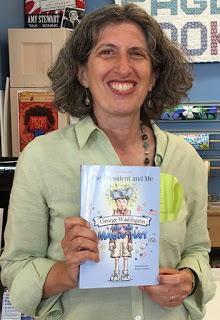
You can keep up with Deborah at her author site (which includes buy links for her books). And, of course, you can keep up with her here at Smack Dab as well! She'll be blogging her each
October 28, 2020
Everybody on the Bus for the Field Trip!
By Charlotte Bennardo
 Photo by Anna Shvets from Pexels
Photo by Anna Shvets from Pexels
No field trips because of Covid-19? That's not true! Okay, so you won't be going by bus, plane, train, or car, and your class, like you, are stuck at home. What to do?
Online Museum Tours
Yep, online you can go anywhere! Check this out:
You are taking a tour of NASA's Langley Research Center in Ohio. How about NASA Glenn where you can tap into tours on various missions, shuttlecrafts, and scientists.
Not really the science type? How about a visit to one of the most restricted places in the world, where you need a special appointment to see some of the worlds most priceless and exceptional art- the Vatican! You can see artworks most people will never get to see (unless they go online), the Sistine Chapel, and many other treasures.
Ever want to go to the the Smithsonian? Natural history, art, cultural items (like the Hope diamond), cool stuff like an Egyptian pyramid- you'll want to spend hours on the various different virtual tours.
Maybe you're not a big fan of history- how about the Google Art Project which is interactive and very, very cool.
Other museums: the Louvre, the British Museum, National Women's History, the Guggenheim, the NY Metropolitan, the NFL, and World wide virtual tours like the Taj Mahal, Cooperstown Baseball Hall of Fame, the Museum of Flight, the Palace of Versailles, even the Great Wall of China and many national and world parks.
You don't even have to pack a lunch or get out of your jammies while you take in so many interesting places. And don't let the links above be the last or only places you visit: search the internet for wherever it is you want to go or for whatever you want to see- and have a grand adventure!
October 27, 2020
Pantsing the Principal for the Win
When I wrote the Aleca Zamm series, I had a lot of fun coming up with crazy situations that could arise from a ten year old having the ability to stop time. But after a few school visits, I quickly learned that one scene stole the show.
In the first book in the series, Aleca uses her newfound ability to cut the mean principal's suspenders while time stands still. When time starts again, the principal's pants fall down, exposing his sailboat boxer shorts to the entire class.
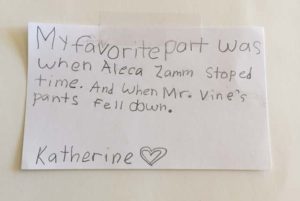
One school I visited asked each of the children to write me a note about their favorite part in the books. I'd say 90% mentioned the pants incident.
So this highly scientific study proves that if you want comedy gold, just pants the principal.
(Offered with my apologies to all the nice principals out there.)
Ginger Rue's next book, Wonder Women of Science, is now available for pre-order. Co-authored with rocket scientist Tiera Fletcher, who is currently working with NASA on the Mars mission, the book profiles a dozen amazing women (besides Tiera!) who are blazing new trails in their respective STEM fields.
<!-- /* Font Definitions */ @font-face {font-family:Times; panose-1:2 0 5 0 0 0 0 0 0 0; mso-font-charset:0; mso-generic-font-family:auto; mso-font-pitch:variable; mso-font-signature:3 0 0 0 1 0;} @font-face {font-family:Cambria; panose-1:2 4 5 3 5 4 6 3 2 4; mso-font-charset:0; mso-generic-font-family:auto; mso-font-pitch:variable; mso-font-signature:3 0 0 0 1 0;} /* Style Definitions */ p.MsoNormal, li.MsoNormal, div.MsoNormal {mso-style-parent:""; margin:0in; margin-bottom:.0001pt; mso-pagination:widow-orphan; font-size:12.0pt; font-family:"Times New Roman"; mso-fareast-font-family:Cambria; mso-fareast-theme-font:minor-latin; mso-bidi-font-family:"Times New Roman"; mso-bidi-theme-font:minor-bidi;} a:link, span.MsoHyperlink {color:blue; text-decoration:underline; text-underline:single;} a:visited, span.MsoHyperlinkFollowed {mso-style-noshow:yes; color:purple; text-decoration:underline; text-underline:single;} p {margin:0in; margin-bottom:.0001pt; mso-pagination:widow-orphan; font-size:10.0pt; font-family:"Times New Roman"; mso-ascii-font-family:Times; mso-fareast-font-family:Cambria; mso-fareast-theme-font:minor-latin; mso-hansi-font-family:Times; mso-bidi-font-family:"Times New Roman";}size:8.5in 11.0in; margin:1.0in 1.25in 1.0in 1.25in; mso-header-margin:.5in; mso-footer-margin:.5in; mso-paper-source:0;} div.Section1 {page:Section1;}</style> <br /></p> <p class="MsoNormal" style="margin-bottom: .1pt; margin-left: 0in; margin-right: 0in; margin-top: .1pt; mso-para-margin-bottom: .01gd; mso-para-margin-left: 0in; mso-para-margin-right: 0in; mso-para-margin-top: .01gd;"><span style="font-family: Times; font-size: 10.0pt; mso-bidi-font-family: "Times New Roman";"><style><!-- /* Font Definitions */ @font-face {font-family:Cambria; panose-1:2 4 5 3 5 4 6 3 2 4; mso-font-charset:0; mso-generic-font-family:auto; mso-font-pitch:variable; mso-font-signature:3 0 0 0 1 0;} /* Style Definitions */ p.MsoNormal, li.MsoNormal, div.MsoNormal {mso-style-parent:""; margin:0in; margin-bottom:.0001pt; mso-pagination:widow-orphan; font-size:12.0pt; font-family:"Times New Roman"; mso-fareast-font-family:Cambria; mso-fareast-theme-font:minor-latin; mso-bidi-font-family:"Times New Roman"; mso-bidi-theme-font:minor-bidi;}size:8.5in 11.0in; margin:1.0in 1.25in 1.0in 1.25in; mso-header-margin:.5in; mso-footer-margin:.5in; mso-paper-source:0;} div.Section1 {page:Section1;}</style> <br /></span></p> <p><style><!-- /* Font Definitions */ @font-face {font-family:Times; panose-1:2 0 5 0 0 0 0 0 0 0; mso-font-charset:0; mso-generic-font-family:auto; mso-font-pitch:variable; mso-font-signature:3 0 0 0 1 0;} @font-face {font-family:Cambria; panose-1:2 4 5 3 5 4 6 3 2 4; mso-font-charset:0; mso-generic-font-family:auto; mso-font-pitch:variable; mso-font-signature:3 0 0 0 1 0;} /* Style Definitions */ p.MsoNormal, li.MsoNormal, div.MsoNormal {mso-style-parent:""; margin:0in; margin-bottom:.0001pt; mso-pagination:widow-orphan; font-size:12.0pt; font-family:"Times New Roman"; mso-fareast-font-family:Cambria; mso-fareast-theme-font:minor-latin; mso-bidi-font-family:"Times New Roman"; mso-bidi-theme-font:minor-bidi;}size:8.5in 11.0in; margin:1.0in 1.25in 1.0in 1.25in; mso-header-margin:.5in; mso-footer-margin:.5in; mso-paper-source:0;} div.Section1 {page:Section1;}</style></p>
October 26, 2020
Where Do You Get Your Ideas? (Holly Schindler)
This is by far the most frequent question I get from students during any kind of Q&A.
The thing is, ideas are the easiest thing to come by. Ideas, in short, are everywhere.
Mostly, I think what they’re really asking is: How do you recognize an idea? How do you know it could actually be a book?
Adults ask the same thing, to be honest.
The best thing you can do is start to keep an idea journal.
Don’t worry about whether or not it’s big enough to be a book. Don’t worry about whether it’s been done before. Just write it down. All of it. Cool characters you meet in your daily life. Funny tidbits. Thoughts you had. Feelings. Places you went. Keep your notebook with you—in your purse or back pocket. Or type it into your phone (but be sure to put that file somewhere accessible—the whole point is not to lose it)!
Just write. Write it all. Play. Write titles. Write short poems. Play with what-ifs.
As you play with ideas, you’ll find some of them merge. Some of them follow a line of thought.
Some of them begin to form the outline of a story big enough to be a book.
And the beautiful part is, the more you write your ideas, the more you play with ideas, the more you’ll realize: ideas really are everywhere.
October 23, 2020
The Treasure Between Your Lines: Smack Dab in the Imagination by Dia Calhoun
When I am stuck in a novel or want to delve deeper into a scene, I often crack open a new direction by imagining what is happening between my sentences.
First, using the computer, I put each existing sentence in a scene or a description on a separate line. Then I add spacing between the sentences. Then I print it out.
After reading a sentence, I imagine what is unsaid, hinted at, left out. I imagine who or what else might be speaking. I use that ancient, old-fashioned tool called a pencil, and start writing. I do that for each sentence--sometimes even between words in a sentence.
This process helps me bypass my over-rational, limited, conscious self and delve deeper into my unconscious. I have no expectations for what "should" happen between the sentences. I don't follow plot or character arcs; nothing is planned.
Often I find one nugget, a bit of description or dialogue for example, that opens up my ideas about the story or character. Sometimes this even leads to a revelation.
Give it a try. What treasure may be lurking between your lines?
October 22, 2020
Interview with Lamar Giles, author of THE LAST MIRROR ON THE LEFT
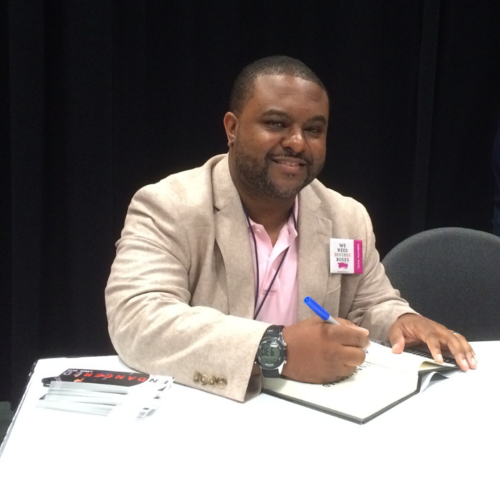
Today, we’re joined by Lamar Giles, author of THE LAST MIRROR ON THE LEFT. I (Holly Schindler, administrator of Smack Dab) was delighted to get my hands on a copy of MIRROR. I absolutely loved THE LAST LAST-DAY-OF-SUMMER, and I was anxious to find out where Giles would take the characters and story. He absolutely did not disappoint:
HS: THE LAST MIRROR ON THE LEFT is such a fun time travel / alternate dimension read. Please tell us a bit about Warped World.
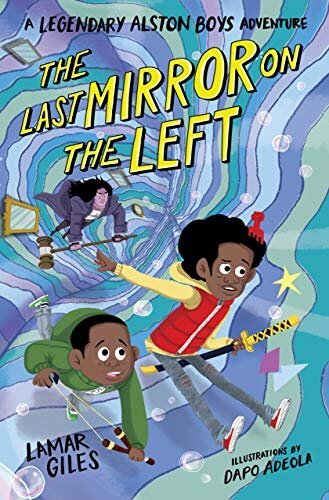
LG: The Warped World is where you go when you step through the interdimensional funhouse mirror inside of The Rorrim Mirror Emporium. Much like a funhouse mirror distorts your characteristics in extreme ways, the residents of Warped World exist as extreme versions of characters you might’ve met in The Last Last-Day-of-Summer. And if you stay there long enough, you might begin to change in some extreme ways, too.
HS: Would you consider this a sequel, or a standalone featuring two characters we were lucky to meet previously?
LG: Definitely a sequel. I’m really big on treating the fictional spaces I write about as snapshots of a living universe. So, decisions made in book 1 can’t be separated from how the characters think and act in book 2. Could someone pick up Last Mirror and enjoy it without reading Last Last Day, possibly…but I think they’ll find the story richer if they’ve been on Otto and Sheed’s previous adventure.
HS: Was it hard to find the right tone / groove for these characters? How hard was it to return to the right mindset?
LG: Not at all. It’s harder for me to get out of the wacky adventure mindset required for an Otto and Sheed adventure than get into it. I always want to exist in a world of fantastic magic where you meet new and amazing friends that fight for right alongside you. Writing Otto and Sheed is often how I wash away some of the ickiness we deal with in the real world.
HS: What's it been like working with illustrator Dapo Adeola?
LG: A dream. I mean, you’ve seen his work, so you know the skill and quality you’re getting. But Dapo is also a lovely human being that I can spend hours talking to. In fact, when we do talk, it’s rarely about work because we’re both professionals who respect what the other brings to the table, that part is more like I do my thing, and he does his. When we talk it’s about movies, comics, and TV we’re enjoying. And how I have a guest room ready for him whenever he decides to visit the States (he’s based in London).
HS: I'm constantly amazed and your ability to write adventure. When THE LAST LAST-DAY-OF-SUMMER came out, we talked about writing action scenes. This time around, can you offer some advice for plot structure and adventure?
LG: I wish I had some really groundbreaking take on how to adventure, but I keep coming back to something one of my writing mentors told me years ago…don’t stay in the same place for too long. That means if you’re in an action scene, end it and give the reader a break. If you’re in a slow moment, make sure something fast is around the corner. If the character is thinking, make sure they’re going to talk soon. If they’re talkative, be sure to eventually describe a significant sight, sound, taste or smell that they’re experiencing between breaths. Instinctively learn when and how to switch gears and you’re writing page turners.
HS: This book has some great humor as well! How do you approach humor when writing for kids?
LG: I honestly don’t think of it as writing humor for kids. I’m writing the things I think are funny and would’ve thought was funny when I was Otto and Sheed’s age. I believe if I went into thinking I’m going to write this joke/gag that I think a young reader will find funny but isn’t really funny to me, it would fall flat. So, the first laugh I’m going for is my own. I just happen to think me and my readers would find a lot of the same stuff hilarious.
HS: Where'd you get the idea for Warped World?
LG: Warped World felt like a—this may sound funny, but—LOGICAL (as much as anything in Logan County can be) progression from the concept of a “Mirror Prison” introduced in The Last Last Day of Summer. Once I went down the path of mirrors being things you could pass through, it made me think of how different mirrors can be. There are several in my house that are different shapes and sizes, though those all do the same thing—reflect what’s in front of them—it seemed reasonable it wouldn’t work that way in Missus Nedraw’s shop. What if the size and shape and frame of a mirror indicated the sort of passage it was? Once I went there, I thought, “Oh…what about a funhouse mirror?”
HS: What bigger message do you want kids to get from MIRROR?
LG: First of all, fun. I want my readers to have a good time…while considering how the justice system works differently for different people, and how there have been instances where folks who make the rules our society lives by have considered themselves above the standards they enforce, or worse, they simply punish others for personal gain. In other words, consider why the rule exists and who made it before you determine who should or shouldn’t be held accountable for breaking it.
HS: Will we get to meet up with these characters again?
LG: We most certainly will. I don’t know exactly how much I’m allowed to say about the future of our heroes and their friends, but there will definitely be another Otto and Sheed adventure soon. Stay tuned for the scoop on what’s happening in and around Logan County next.
~
I absolutely cannot wait for the next installment. This would make a fantastic “classroom” book, reglardless of what your classroom looks like this year: kitchen table, bedroom, under a tree, virtual setting, etc.

Catch up with Giles at his author author site, and be sure to snag a copy of THE LAST MIRROR ON THE LEFT!
October 21, 2020
Interview with M.L. Tarpley, Author of MAYLIE AND THE MAZE
HS: Hey, M.L.! We're so delighted to have you at Smack Dab. Please tell us about Maylie and the Maze, which just released this month. Elevator pitch.
MLT: “Maylie and the Maze” is middle grade realistic fiction that follows 10-year-old Maylie Montes on an inspirational trip across Europe filled with the shenanigans of her zany family and the mishaps of her overactive imagination.It will appeal to fans of the Middle School series by James Patterson, The Tapper Twins series by Geoff Rodkey, and the Melanie Martin series by Carol Weston.
HS: Most authors have a long and winding publishing journey. What was yours like? Were you a young author like Maylie?
MLT: Yes, definitely a long and winding journey for me.
I've always loved reading and writing, stories and storytelling. I wrote my first novel when I was 12. It's horribly hilarious. It went on for like 30 or more chapters, and it never ended.
After I wrote that very long, ongoing book in junior high, then I went high school and was busy writing essays and research papers, which I strongly dislike, and then I went to college and studied journalism. I didn't take any creative writing classes or anything, but the heart of journalism is asking questions, the right ones, and so it is as an author. To write a story, you must ask one specific question—what if?
What if this happened or this happened? That to me is the spark of a story. That's what I like to call it. And it's something that Maylie learns.
I didn't start writing novels until I was out of college, which was a decade ago. I’ve spent these years learning the craft of writing fiction, attending writer’s conference and webinars, reading writing books, and writing a lot of bad first drafts. (Ha.) As with any skill, you have to practice and put in the time. And you have to learn from the best.
In 2013 I had the idea for the series. I can't remember what the exact spark was, but I had traveled to over a dozen countries and those experiences provided the stage for my novels. I wanted to write a series where kids could travel all over the world and see the countries like they would as a tourist. That was the heart of it.
HS: How did you decide on your publishing method?
In 2017, while I was pregnant with my son, I looked at that story idea from several years before and started writing the book. I finished the first draft in 2018, edited it, sent it out to agents, and got rejections. I worked with a professional editor who offered great feedback to rewrite parts of the book and strengthen the storyline. It was at that point that I realized that I really didn't want to query the book because I had a specific vision for it, including how it would look with illustrations, and I didn't want to sacrifice the full control over it.
I didn't know anything about self-publishing at the time, but I learned and in March 2020 decided to self-publish my novel, so literally, this was a COVID project.
It has been a huge learning curve this year, but it's been great, and I'm really pleased with the final product.
(View the full trailer here.)
HS: You have a fantastic MG voice. How did you tap into it?
MLT: Thank you! Whew…I’m so glad you think so.
I still feel like I’m 10 years old a lot of the time (ha!). It is like ideas for stories geared to kids in middle grade and younger just pop into my brain. I wouldn’t have it any other way! I also have a toddler and over a dozen nieces and nephews, so I have plenty of firsthand experience with kids too.
One of my favorite things to do is settle in at a coffee shop with a composition notebook and pen and just let my imagination run free! I love to scribble away while sipping on a latte.
And re-reading my diaries from when I was a kid helped too. They’re very funny to read and help me remember what was important to me at that age and what my thought process was like, etc. Very enlightening!
HS: Totally agree about those diaries! I read several of the poetry journals I kept in high school before drafting my first YA. Moving away from the text a bit, I have to say that the illustrations add so much to the book! What was it like to work with an illustrator?
MLT: I think so too! It was really neat to see my book truly come to life through the illustrations. Artist Monica Bruenjes (www.artistmonica.com) is very talented!
It was a learning process for me to work with her. She was so great, but I didn’t know what I was doing! (Ha!) We worked out a system for my notes and merging both of our visions into crafting each illustration.
HS: I love the tagline STORIES THAT TAKE YOU PLACES. It seems especially important in these times, when we’re all spending so much time at home. Do you hope the book will provide your readers a much-needed escape?
MLT: Yes, I certainly hope Maylie and the Maze can be a much-needed escape.
Throughout this series, I want kids (and adults alike) to have a chance to travel the world through fiction and along the way learn a bit. I’ve tapped into my own first-hand experiences from traveling to over a dozen countries and filtered them through Maylie’s eyes.
In this instance, the story is set in England, particularly at Leeds Castle in southern England. The castle is absolutely gorgeous! It’s known as the “loveliest castle in the world” for a reason. And it’s nearly 1,000 years old. Isn’t that amazing?!
The book had to be set in England because that’s where the maze is located. Plus, I love England! I love the countryside and manor houses and castles and the mix of modern-day and history in the city of London. My favorite place is the city of Bath.
One of my favorite memories in England is staying a few nights in a 500-year-old thatched cottage in a tiny English village surrounded by green fields edged with low stone fences and full of sheep. It was idyllic and quite inspiring for a creative’s mind!
HS: In many ways, this is a story about the writing process, which I found really intriguing. What’s your own process like?
MLT: I’m a total plotter. I have outlines that have outlines that have outlines. Lol
But I LOVE brainstorming and scribbling away on my ideas in a notebook. It’s a lot of fun!
I first write down the heart of the story as I know it, and the direction I feel it should go. I research the country and tourist attractions to see what nuggets of inspiration will pop up, then I start writing out scene ideas and string them together in an outline. I write my stories from start to finish and don’t skip around. I like to follow along with the story as it flows.
After the first draft is done, I let it sit for a few days before the first edit and then it goes to my critique partner to read and then more edits and so on.
HS: What’s one piece of advice you’d give to young authors?
MLT: My advice to writers of any age is to write, just sit and write and invest the time. Just like you would if you went to further your education in training, in college, or on the job. Make sure to read the genre you are writing to get a feel for how it’s done.
Do writing prompts. Practice. To do anything well we have to put in the time and effort. Writing is no different.
Maylie and the Maze centers on one of Maylie’s main struggles being that she longs to become an author, but she can’t finish a story. I feel like that is a struggle for so many—kids and adults alike, so I decided to write a companion non-fiction book that I would give to a kid like Maylie.
The book, “Young Writer’s Kit: A Guide for Young Writers,” teaches kids how to write fictionand includes a fun genre matching game, writing prompts, and more. It’s currently available for purchase on Amazon; though a free condensed PDF version is available for those who sign up for my newsletter, which anyone interested can do here: www.mltarpleybooks.com
I wish I would have had someone at that time, who was a writer, who said if you really want to do this, here's how. And so through this series, even though it's fiction, I want to teach children how to write their own stories.
HS: What’s next for you?
MLT: I’ve written the next book in the series and will start working with the illustrator on it soon. It will publish in Spring 2021. I am currently writing the third book, which will release Fall 2021. I am also working on a picture book series and have the idea for a chapter book series stirring in my mind. Exciting!
Exciting, indeed! Keep up with all things M.L. Tarpley at her author site, and you can snag a copy of Maylie's story here.
October 20, 2020
To Be- Well, Not Today
Today's new math lesson:
 Photo courtesy of Pexels
Photo courtesy of Pexels
Allergies + Congestion = Bronchitis.
So I'm taking off for a week.
Send cookies, chai lattes, and good books.
Char

